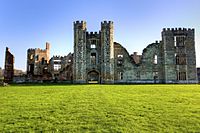Mary Wriothesley, Countess of Southampton facts for kids
Quick facts for kids Mary Wriothesley |
|
|---|---|
| Countess of Southampton | |
| Portrait by Hans Eworth, 1565 | |
| Spouse(s) | |
| Issue | |
| Noble family | Browne |
| Father | Anthony Browne, 1st Viscount Montagu |
| Mother | Jane Radcliffe |
| Born | 22 July 1552 |
| Died | October/November 1607 (aged 55) |
Mary Wriothesley, born Mary Browne (July 22, 1552 – October/November 1607), was an important English noblewoman. She became the wife of Henry Wriothesley, 2nd Earl of Southampton, when she was just thirteen years old. Later, she became the mother of Henry Wriothesley, 3rd Earl of Southampton.
After her first husband passed away in 1581, she was known as the Dowager Countess of Southampton. This title is given to the widow of an earl. In 1595, she married Sir Thomas Heneage, a courtier, but he died a few months later. Her last marriage was in 1598 to Sir William Hervey.
Early Life and First Marriage
Mary Browne was born on July 22, 1552. Her father was Anthony Browne, 1st Viscount Montagu. Her mother was Lady Jane Radcliffe. Mary had a twin brother named Anthony. Sadly, their mother passed away shortly after they were born.
When Mary was thirteen, on February 19, 1565/66, she married Henry Wriothesley, 2nd Earl of Southampton. He was a "royal ward," meaning he was a young noble under the care of the King or Queen until he was old enough to manage his own lands. Henry was twenty years old at the time.
In 1566, Henry turned twenty-one and gained control of his large estates. He had six homes and a good income, so he lived a very grand life. However, Mary's life with Henry was sometimes difficult because of his strong Catholic faith, which was not always favored by the Queen.

Mary and Henry had one son, Henry Wriothesley, 3rd Earl of Southampton, and two daughters, Jane and Mary. Jane passed away when she was very young. Their daughter Mary later married Thomas Arundell, 1st Baron Arundell of Wardour.
In 1573, Henry was very happy to share the news of his son's birth. For the next six years, their family life was stable. The Queen even showed Henry small signs of favor. After his mother died in 1574, Henry started building a large new country house at Dogmersfield.
Mary and Henry were close until about 1577. But then, they had a disagreement, and their relationship became difficult. In 1580, Henry asked Mary to live separately on one of his estates in Hampshire. Her father, Lord Montagu, tried to understand what happened. Mary sent him a copy of a letter she had written to Henry, but Henry had refused to read it.

Mary did not see her son again until after his father passed away. Henry, the 2nd Earl of Southampton, died on October 4, 1581. Mary then became the Dowager Countess of Southampton. She had some disagreements about his will, but she was able to resolve them with the help of the Earl of Leicester.
Life as a Widow
After Henry's death, Queen Elizabeth decided who would care for Mary's young son. She sold the "wardship" (the right to care for a young noble and his estates) to Lord Howard of Effingham for £1,000. Lord Howard then transferred the care of young Henry to Lord Burghley.
As a result, young Henry, who was only eight years old, went to live at Cecil House in London. However, he still spent time with his mother. In 1590, Mary wrote to Lord Burghley to thank him for letting her son stay with her for a long time.
Mary remained a widow for nearly fourteen years. On May 2, 1594, she married Sir Thomas Heneage. He was the Vice-Chamberlain of the Queen's Household. Sadly, Sir Thomas lived for only five more months. He died owing a large amount of money to the crown.
Mary, as his executor, had to pay back this debt. She made two large payments, but still owed a lot of money. It is believed she had to use her own money to help pay off this debt.
Between November 1598 and January 1599, Mary Heneage married for the third time to Sir William Hervey. She lived for almost nine more years, passing away in October or November 1607.
In her will, Mary asked to be buried at Titchfield. She wanted to be buried "as near as may be" to her first husband, Henry, the 2nd Earl of Southampton. A few days after her death, Thomas Howard, 2nd Earl of Arundel, wrote that Mary had left most of her belongings to her son and her husband.

